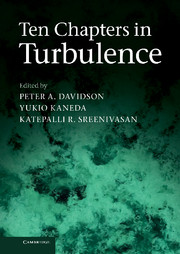Book contents
- Frontmatter
- Contents
- Preface
- Contributors
- 1 Small-Scale Statistics and Structure of Turbulence – in the Light of High Resolution Direct Numerical Simulation
- 2 Structure and Dynamics of Vorticity in Turbulence
- 3 Passive Scalar Transport in Turbulence: A Computational Perspective
- 4 A Lagrangian View of Turbulent Dispersion and Mixing
- 5 The Eddies and Scales of Wall Turbulence
- 6 Dynamics of Wall-Bounded Turbulence
- 7 Recent Progress in Stratified Turbulence
- 8 Rapidly-Rotating Turbulence: An Experimental Perspective
- 9 MHD Dynamos and Turbulence
- 10 How Similar is Quantum Turbulence to Classical Turbulence?
- References
2 - Structure and Dynamics of Vorticity in Turbulence
Published online by Cambridge University Press: 05 February 2013
- Frontmatter
- Contents
- Preface
- Contributors
- 1 Small-Scale Statistics and Structure of Turbulence – in the Light of High Resolution Direct Numerical Simulation
- 2 Structure and Dynamics of Vorticity in Turbulence
- 3 Passive Scalar Transport in Turbulence: A Computational Perspective
- 4 A Lagrangian View of Turbulent Dispersion and Mixing
- 5 The Eddies and Scales of Wall Turbulence
- 6 Dynamics of Wall-Bounded Turbulence
- 7 Recent Progress in Stratified Turbulence
- 8 Rapidly-Rotating Turbulence: An Experimental Perspective
- 9 MHD Dynamos and Turbulence
- 10 How Similar is Quantum Turbulence to Classical Turbulence?
- References
Summary
Introduction
Ancient depictions of fluids, going back to the Minoans, envisaged waves and moving streams. They missed what we would call vortices and turbulence. The first artist to depict the rotational properties of fluids, vortical motion and turbulent flows was da Vinci (1506 to 1510). He would recognize the term vortical motion as it comes from the Latin vortere or vertere: to turn, meaning that vorticity is where a gas or liquid is rapidly turning or spiraling. Mathematically, one represents this effect as twists in the velocity derivative, that is the curl or the anti-symmetric component of the velocity gradient tensor. If the velocity field is u, then for the vorticity is ω = ∇ × u.
The aspect of turbulence which this chapter will focus upon is the structure, dynamics and evolution of vorticity in idealized turbulence – either the products of homogeneous, isotropic, statistically stationary states in forced, periodic simulations, or flows using idealized initial conditions designed to let us understand those states. The isotropic state is often viewed as a tangle of vorticity (at least when the amplitudes are large), an example of which is given in Fig. 2.1. This visualization shows isosurfaces of the magnitude of the vorticity, and similar techniques have been discussed before (see e.g. Pullin and Saffman, 1998; Ishihara et al., 2009; Tsinober, 2009). The goal of this chapter is to relate these graphics to basic relations between the vorticity and strain, to how this subject has evolved to using vorticity as a measure of regularity, then focus on the structure and dynamics of vorticity in turbulence, in experiments and numerical investigations, before considering theoretical explanations. Our discussions will focus upon three-dimensional turbulence.
- Type
- Chapter
- Information
- Ten Chapters in Turbulence , pp. 43 - 86Publisher: Cambridge University PressPrint publication year: 2012
References
- 1
- Cited by



